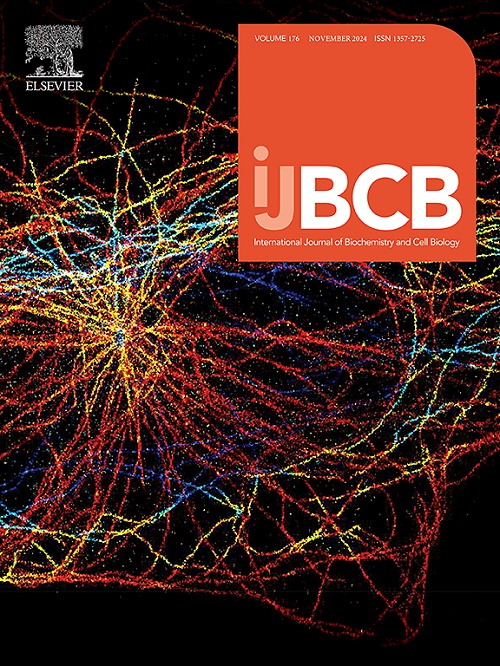选择性脑低温通过增强Drp1的SUMO2/3修饰减轻大鼠局灶性脑缺血再灌注损伤
IF 2.8
3区 生物学
Q2 BIOCHEMISTRY & MOLECULAR BIOLOGY
International Journal of Biochemistry & Cell Biology
Pub Date : 2025-03-21
DOI:10.1016/j.biocel.2025.106772
引用次数: 0
摘要
选择性脑低温(SCH)已被证明可以增强SUMO2/3的修饰,SUMO2/3是一种天然的细胞保护机制,可以抵抗脑缺血/再灌注损伤(CIRI)。动力蛋白相关蛋白1 (Dynamin-Related Protein 1, Drp1)是线粒体裂变途径中的关键调节因子,是SUMO2/3修饰的重要底物。然而,SCH对SUMO2/3修饰Drp1的影响尚不清楚。因此,本研究假设SCH增强了Drp1的SUMO2/3修饰,从而保持了线粒体的完整性并减轻了CIRI。方法建立Sprague-Dawley大鼠局灶性CIRI模型,经颈动脉灌注20°C生理盐水诱导SCH, 37°C生理盐水作为对照组。采用改良的神经系统严重程度评分(mNSS)来量化神经功能缺损的程度。2,3 - 5-三苯四唑氯(TTC)染色检测脑梗死体积。苏木精-伊红(HE)染色观察神经细胞组织学变化。采用末端脱氧核苷酸转移酶介导的dUTP镍端标记(TUNEL)免疫荧光染色评价神经细胞凋亡。Western blot (WB)检测Drp1和Cytochrome c的表达,采用免疫共沉淀法检测SUMO2/3对Drp1的修饰水平。透射电镜观察线粒体超微结构。共聚焦显微镜下观察M-Drp1与T-Drp1的比值及线粒体形态变化。结果研究数据显示,当CIRI发生时,SCH显著增强了Drp1的SUMO2/3修饰。同时,SCH组的mNSSs、脑梗死体积和凋亡率均显著降低,证实了SCH的保护作用。线粒体外膜Drp1 (M-Drp1)、细胞质细胞色素C (C- cytc)表达水平降低,M-Drp1 / T-Drp1比值降低,线粒体超微结构和形态变化减轻,说明SCH对线粒体裂变有抑制作用。相比之下,与20°C盐水灌注相比,37°C盐水的保护作用可以忽略不计。结论在大鼠模型中,SCH扩增了SUMO2/3对Drp1的修饰,减少了过度的线粒体分裂,从而改善了局灶性CIRI。本文章由计算机程序翻译,如有差异,请以英文原文为准。
Selective cerebral hypothermia alleviates focal cerebral ischemia/reperfusion injury via enhancing SUMO2/3 modification of Drp1 in rats
Background
Selective Cerebral Hypothermia (SCH) has been demonstrated to potentiate SUMO2/3 modification, a native cellular safeguard against Cerebral Ischemia/Reperfusion Injury (CIRI). Dynamin-Related Protein 1 (Drp1), a pivotal regulator in the mitochondrial fission pathway, is an important substrate for SUMO2/3 modification. However, effects of SCH on SUMO2/3 modification of Drp1 remain undefined. Herein, the current study posits that SCH augments the SUMO2/3 modification of Drp1, thereby preserving mitochondrial integrity and mitigating CIRI.
Methods
A focal CIRI model was established in Sprague-Dawley rats, with 20°C saline perfused via the transcarotid artery to induce SCH condition, and 37°C saline serving as a control. The modified Neurological Severity Score (mNSS) was used to quantitate the degree of neurological deficits. Staining of 2,3–5-triphenyltetrazolium chloride (TTC) was performed to detect cerebral infarction volume. Histological change of neurocyte was observed through Hematoxylin-eosin (HE) staining. Neurocyte apoptosis was evaluated using terminal deoxynucleotidyl transferase-mediated dUTP nick-end labeling (TUNEL) immunofluorescence staining. Western blot (WB) was utilized to evaluated the expressions of Drp1 and Cytochrome C. Co-immunoprecipitation was performed to evaluate the level of SUMO2/3 modification of Drp1. And transmission electron microscopy was used to observe the mitochondrial ultrastructure. The ratio of M-Drp1 to T-Drp1 and mitochondria morphological changes were observed under confocal microscopy.
Results
Research data revealed that SCH significantly enhanced the SUMO2/3 modification of Drp1 when CIRI occurred. Concurrently, mNSSs, cerebral infarct volume, and apoptotic rates were notably attenuated in the SCH group, corroborating SCH's protective role. Expression levels of mitochondrial outer membrane Drp1 (M-Drp1), cytoplasmic cytochrome C (C-CytC), and ratio of M-Drp1 to T-Drp1 were reduced, and changes of mitochondrial ultrastructural and morphology were mitigated, underscoring SCH's inhibitory effect on mitochondrial fission. In contrast, 37°C saline displayed negligible protective impact while compare with 20°C saline perfusion.
Conclusions
The findings support that SCH amplifies SUMO2/3 modification of Drp1, curtails excessive mitochondrial fission, and consequently ameliorates focal CIRI in a rat model.
求助全文
通过发布文献求助,成功后即可免费获取论文全文。
去求助
来源期刊
CiteScore
8.10
自引率
0.00%
发文量
124
审稿时长
19 days
期刊介绍:
IJBCB publishes original research articles, invited reviews and in-focus articles in all areas of cell and molecular biology and biomedical research.
Topics of interest include, but are not limited to:
-Mechanistic studies of cells, cell organelles, sub-cellular molecular pathways and metabolism
-Novel insights into disease pathogenesis
-Nanotechnology with implication to biological and medical processes
-Genomics and bioinformatics

 求助内容:
求助内容: 应助结果提醒方式:
应助结果提醒方式:


